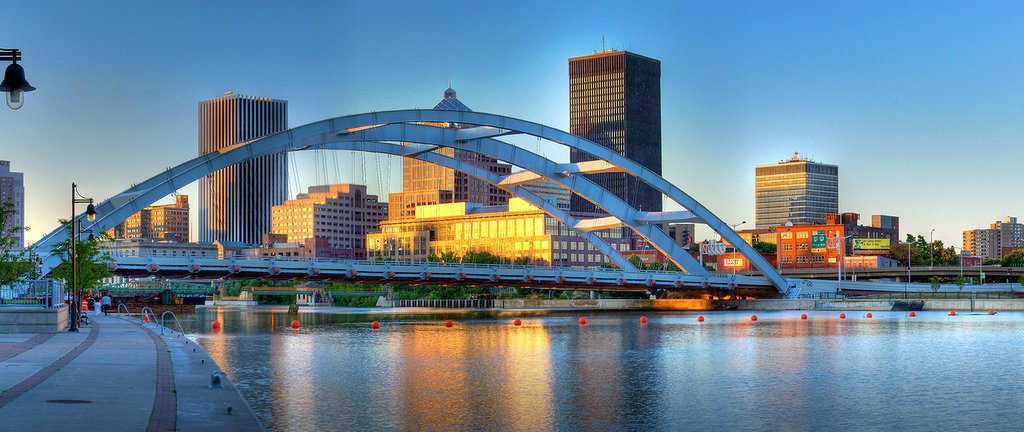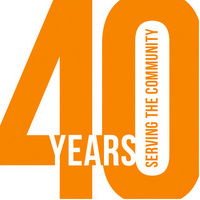The Community We Serve
Rochester is the seat of Monroe County, New York. Situated east of Buffalo, west of Syracuse and northwest of New York City, it is at the center of a large metropolitan area that encompasses and extends beyond Monroe County to include the counties of Genesee, Livingston, Ontario, Orleans, and Wayne. This area, which is part of the Western New York region, has a population of approximately 1,700,000. The City of Rochester has a population of approximately 210,000, making it New York’s third most populous city after New York City and Buffalo. Located on the southern shore of Lake Ontario, where the Great Lakes meet the vineyard-dotted Finger Lakes, Rochester provides easy access to a wealth of four-season outdoor recreation.
History
Rochester became America’s first 19th Century “boomtown” and rose to prominence initially as the site of many flour mills located on the Genesee River, then a major manufacturing hub.
In 1830-31, Rochester experienced one of the nation’s biggest revivalist movements, led by Charles Finney. The revival has been noted as inspiring other revivals of the Second Great Awakening. A leading pastor in New York who was converted in the Rochester meetings gave the following account of the effects of Finney’s meetings in that city:
The whole community was stirred. Religion was the topic of conversation in the house, in the shop, in the office and on the street. The only theater in the city was converted into a livery stable; the only circus into a soap and candle factory. Grog shops were closed; the Sabbath was honored; the sanctuaries were thronged with happy worshipers; a new impulse was given to every philanthropic enterprise; the fountains of benevolence were opened, and men lived to good.
By the mid-19th century, as the center of the wheat-processing industry moved west with population and agriculture, the city became home to an expanding nursery business, giving rise to the city’s second nickname, the “Flower City”. Nurseries ringed the city, the most famous of which was started in 1840 by immigrants Georg Ellwanger from Germany and Patrick Barry from Ireland.
In 1847, Frederick Douglass founded the abolitionist newspaper The North Star in Rochester. Douglass, a former slave and an antislavery speaker and writer, gained a circulation of over 4,000 readers in the United States, Europe, and the Caribbean. The North Star served as a forum for abolitionist views.
Susan B. Anthony, a national leader of the women’s suffrage movement, was from Rochester. The Nineteenth Amendment to the United States Constitution, which guaranteed the right of women to vote in 1920, was known as the Susan B. Anthony Amendment because of her work toward its passage, which she did not live to see.
Current
Today, Rochester is an international center of higher education as well as medical and technological development. The region is known for many acclaimed universities, and several of them (notably the University of Rochester and the Rochester Institute of Technology) are nationally renowned for their research programs. In addition, Rochester continues to be the site of many important inventions and innovations in consumer products.
The Rochester metropolitan area is the second largest regional economy in New York State, after the New York City metropolitan area. Its lively “knowledge economy” draws its strengths from established companies (e.g., Xerox, Bausch and Lomb, Eastman Kodak) and their many small business spin-offs, including growing telecommunications, biotechnology, and information technology enterprises. In recent years, the University of Rochester has become the largest employer in the Rochester area and the seventh largest employer in New York State.
Rochester consistently receives high rankings nationally as a “most livable city,” for overall quality of life, and as among the very best places to raise a family. The region has outstanding, highly ranked public and private schools, with a relatively modest cost of living and a stable, affordable housing market. Home to the renowned Eastman School of Music, the Rochester Philharmonic Orchestra, and the Xerox Rochester International Jazz Festival (among the nation’s most popular and respected), Rochester enjoys economic stability and a level of arts, culture, sports, and dining comparable to that of many larger cities.
For more information about living in Rochester, see report in Wikipedia or visit www.rochestermadeforliving.com or www.visitrochester.com.





